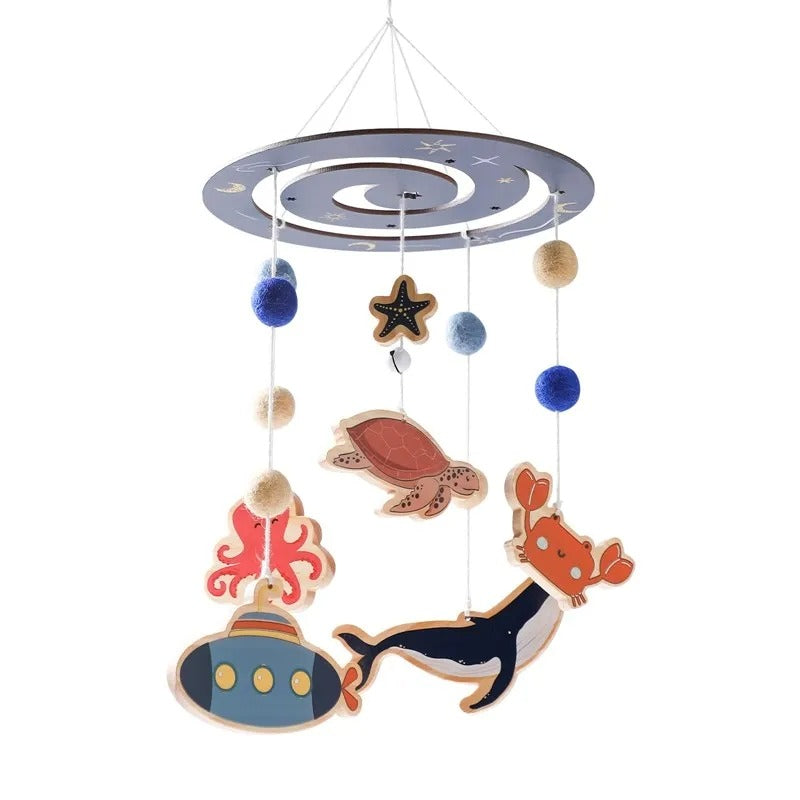Montessori mobiles, inspired by Dr. Maria Montessori's educational philosophy, are designed to nurture a baby's developmental stages through sensory and aesthetic experiences. This comprehensive guide explores Montessori mobiles, highlighting their significance, design principles, and impact on early childhood development, in alignment with Montessori principles.
Understanding Montessori Principles in Mobile Design
Respect for the Child
- Montessori philosophy advocates for respecting a child’s natural development. Mobiles designed in this framework are crafted to meet the developmental needs of infants at various stages, offering the right amount of stimulation without overwhelming them.
Sensitive Periods
- Montessori recognized that children go through sensitive periods of development. Baby cot mobiles are used to capitalize on these periods, particularly for visual and motor development in the first few months of life.
Prepared Environment
- In Montessori, the environment is prepared to encourage independence and learning. Montessori mobiles are part of this prepared environment, offering stimuli that are age-appropriate and aligned with the child’s growing interests.
Types of Montessori Mobiles and Their Purposes
The Munari Mobile
- Used from birth to about 3 months, the Munari is the first Montessori mobile introduced to infants. It’s black and white, providing high contrast visual stimulation that is most suitable for a newborn’s developing sight.
The Octahedron Mobile
- Introduced around 6 weeks to 3 months, this mobile features geometric shapes in primary colors. It helps in developing color perception as an infant’s vision matures.
The Gobbi Mobile
- Suitable for babies around 3 to 6 months old, the Gobbi mobile consists of spheres in graduating shades of a single color. This gradient effect helps refine the baby's depth of field and color discrimination.
The Dancers Mobile
- Used from around 3 months, the Dancers mobile comprises simple figures made with holographic paper. Their light, reflective quality captivates babies, stimulating visual tracking and concentration.
The Bell and Ribbon Mobile
- This interactive mobile is introduced when babies start reaching out and grasping. It encourages motor skills and hand-eye coordination.
Design Elements of Montessori Mobiles
Simplicity and Functionality
- Montessori mobiles are characterized by their simplicity. They lack the electronic stimuli of conventional mobiles, focusing instead on basic forms and movements that encourage natural development.
Natural and Safe Materials
- True to Montessori's emphasis on natural materials, these mobiles are often made of wood, cotton, and metal. They are safe, non-toxic, and environmentally friendly.
Visual Stimulation
- The design of Montessori mobiles is tailored to an infant's visual development. Early mobiles use black and white for contrast, gradually introducing colors and complex shapes as the baby’s sight develops.
Benefits of Montessori Mobiles in Early Development
Visual Tracking and Focus
- Montessori mobiles are designed to promote visual tracking and focus, essential skills in a baby's cognitive development.
Aesthetic Appreciation
- The beauty and simplicity of these mobiles instill an early appreciation for aesthetics and order, core aspects of Montessori education.
Independent Learning
- By providing an object of interest, Montessori mobiles encourage babies to explore and engage independently, fostering early stages of concentration and self-directed learning.
Sensory Development
- These mobiles engage babies in gentle, sensory-based exploration, stimulating but not overwhelming their developing senses.
Integrating Montessori Mobiles into the Nursery
Strategic Placement
- Mobiles should be placed where babies spend a lot of time lying on their backs, such as over a crib or a Montessori bed. The mobile should be positioned at a safe distance, allowing the baby to see but not touch it.
Creating a Calm Environment
- The nursery should be a calm, serene space that complements the simplicity of the Montessori mobile, free from overstimulating elements.
Rotating Mobiles
- As the baby grows and develops, rotate the mobiles to correspond with their developmental stages. This keeps the experience fresh and engaging for the infant.
Challenges and Considerations
DIY vs. Purchased Mobiles
- Montessori mobiles can be homemade or purchased. If making a DIY mobile, ensure it adheres to safety standards and Montessori principles. Purchased mobiles should be from reputable suppliers who understand Montessori philosophy.
Safety Precautions
- Regularly inspect mobiles for any wear and tear. Ensure all parts are secure and that the mobile is safely out of the baby's reach.
Observation and Responsiveness
- Observe the baby’s response to the mobile. Each child is unique, and adjustments might be necessary to align with their individual developmental pace and interest.
Conclusion
Montessori mobiles offer a thoughtful, developmentally appropriate approach to early infant stimulation. By respecting the natural progression of a child’s growth and focusing on simplicity and beauty, these mobiles provide a nurturing start. They not only enhance visual and motor skills but also lay the groundwork for a lifelong love of learning and appreciation for a well-ordered, aesthetically pleasing environment. In the Montessori nursery, the mobile is more than a toy; it's a tool for holistic development, reflecting a profound respect for the child’s individual journey of discovery. Explore Australia's premier collection of BabyCotMobiles! From whimsical cot to elegant nursery mobiles, find the perfect addition to your little one's room. Our handpicked range combines style, quality, and developmental benefits. Shop now for unforgettable designs and create a magical nursery space!



